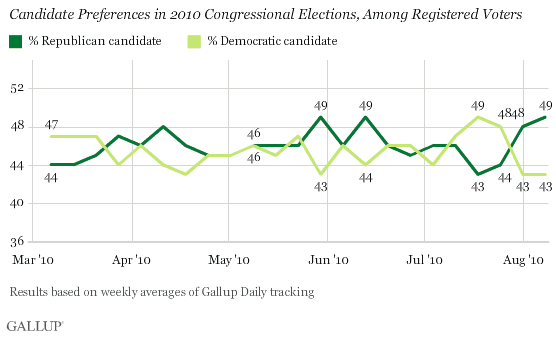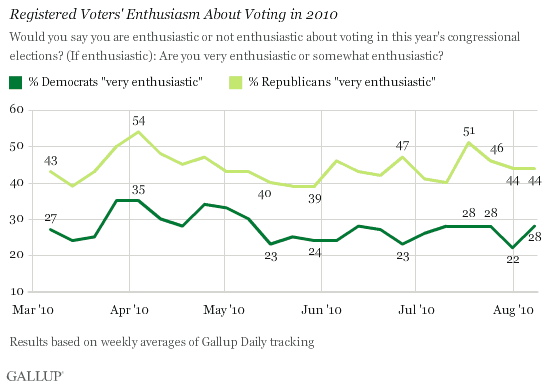PRINCETON, NJ -- Republicans have a 49% to 43% lead over Democrats among registered voters in Gallup's generic ballot for Congress for the week of Aug. 2-8, the second straight week in which Republicans have held an edge in projected voting.

The current six-percentage-point Republican lead ties the largest for either party so far, although Republicans have generally tied or held an advantage over Democrats since Gallup began tracking the generic ballot in March. The major exception to this prevailing pattern came July 12-25, when Democrats moved ahead with six- and four-point weekly advantages.
Republicans have maintained at least a 10-point advantage in voting enthusiasm since March, including this past week's 16-point lead over Democrats in the percentage who are "very enthusiastic" about voting. The widest such gap was 24 points in late June.

Implications
Gallup's weekly generic ballot updates are based on relatively large sample sizes -- more than 1,500 interviews with registered voters in most weeks -- providing a solid sample base for estimated voting intentions. The Republican and Democratic Parties have essentially been tied on a number of occasions -- with some upticks in GOP support from time to time, as has been the case for the past two weeks, but also with a Democratic advantage during the two-week period in July.
Republicans historically enjoy a turnout advantage in midterm elections, meaning that a final pre-election registered-voter margin either tied or tilting in the GOP's direction would almost certainly translate into major Republican seat gains. This possibility is underscored by Republicans' substantial advantage in enthusiasm over Democrats so far this year. However, given that Democratic candidates moved ahead of Republican candidates in the generic ballot for two weeks at the end of July, the possibility exists that Democrats could gain support again between now and Nov. 2.
Results for this Gallup poll are based on telephone interviews conducted as part of the Gallup Daily tracking survey Aug. 2-8, 2010, with a random sample of 1,554 registered voters, aged 18 and older, living in all 50 U.S. states and the District of Columbia, selected using random-digit-dial sampling.
For results based on the total sample of registered voters, one can say with 95% confidence that the maximum margin of sampling error is ±3 percentage points.
Interviews are conducted with respondents on landline telephones and cellular phones, with interviews conducted in Spanish for respondents who are primarily Spanish-speaking. Each daily sample includes a minimum quota of 150 cell phone respondents and 850 landline respondents, with additional minimum quotas among landline respondents for gender within region. Landline respondents are chosen at random within each household on the basis of which member had the most recent birthday.
Samples are weighted by gender, age, race, Hispanic ethnicity, education, region, adults in the household, cell phone-only status, cell phone-mostly status, and phone lines. Demographic weighting targets are based on the March 2009 Current Population Survey figures for the aged 18 and older non-institutionalized population living in U.S. telephone households. All reported margins of sampling error include the computed design effects for weighting and sample design.
In addition to sampling error, question wording and practical difficulties in conducting surveys can introduce error or bias into the findings of public opinion polls.
For more details on Gallup's polling methodology, visit https://www.gallup.com/.
